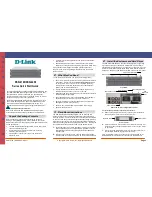
2-6
INSTALLING THE FDMMIM
To demonstrate this MIM interaction, assume that we have an
MMAC-5FNB configuration as follows:
Slot 1 - EMME
Slot 2 - TPRMIM-36
Slot 3 - FDMMIM
Slot 4 - FDCMIM-04
After turning on the MMAC, the TPRMIM checks the MIM in slot 3.
When it determines that slot 3 does not hold an Ethernet MIM, it
activates the relays that terminate the Ethernet section of the B and
C buses. The FDDI MIMs can put FDDI frames on the C bus because
the FDDI portion of the C bus is physically isolated from the
Ethernet portion. This example uses the TPRMIM, but the same
would be true if you were using any of the other RMIMs as well.
For a more thorough description of the RMIMs and how they use the
MMAC buses, see your RMIM documentation.
2.2
INSTALLING THE FDMMIM
Caution: Observe all static precautions when handling boards.
Always leave the FDMMIM inside the protective bag when the MIM
is not installed in an MMAC. If you need to set the MIM down
during installation, set it on a clean, non-conducting surface.
Before you actually install the FDMMIM into the MMAC, you must
activate the battery and set any bridge configuration switches.
2.2.1 Setting Jumpers
Your FDMMIM uses a Nicad battery to maintain power to the RAM
in the event of power loss. The RAM holds all bridge configuration
data. To prevent the battery from discharging during shipment, the
factory sets the battery jumper to the disabled position. You must
enable the battery before you install the FDMMIM. Figure 2-5 shows
the location of the three pin battery jumper. To activate the battery:
•
Position the plastic jumper so that it connects the right two
pins of JP1.
















































